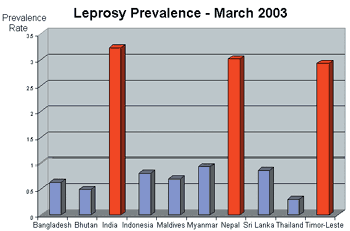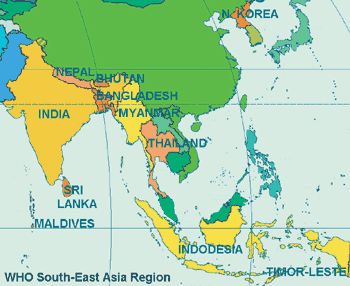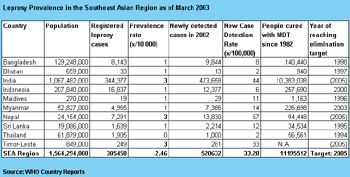
Country Scene in India
|
| SEAR REPORT |
|
Leprosy Elimination Efforts in Southeast Asia
by Dr. Uton Muchtar Rafei, WHO Regional Director for the South East-Asian Region |
| Although the South-East Asian Region (SEAR) is the only WHO region yet to achieve the elimination of leprosy, it has made noteworthy progress and substantially contributed to the achievement of the leprosy elimination goal globally. |
| SEAR Achievements |
| ・ |
Over 90% of the approximately 12 million leprosy cases detected and cured globally are from SEAR, including 10.8 million cured cases in India. |
| ・ |
Seven of the eleven member countries of SEAR attained the elimination goal by the original target date of December 2000 and have maintained elimination levels. Myanmar attained the goal in January 2003. |
| ・ |
The three remaining countries ― India, Nepal and Timor-Leste are making concerted efforts to reach the goal by December 2005. |
| ・ |
The prevalence of leprosy has declined by 92% over the 17-year period from 1985, when Multi-Drug Therapy (MDT)1 was introduced in all countries of the Region. |
| India |
| In spite of the above achievements, it is a matter of concern that the region accounted for 74% of the globally registered cases and 80% of the new cases detected in 2002. India alone accounts for 90% of the regional and 66% of the global caseload. Therefore, WHO is giving the highest priority to India. I must, however, emphasize that the National Leprosy Elimination Program (NLEP) in India is on the right track and has made notable strides. |
| Indian Achievements |
| ・ |
Over 90% of the cases detected and cured in the region are from India. |
| ・ |
India has a good health infrastructure. Leprosy services and adequately trained human resources are now integrated into general health services, bringing MDT to the doorstep of the large majority of leprosy patients. |
| ・ |
Comprehensive advocacy and Information, Education and Communication (IEC) activities, as well as many focused activities like Leprosy Elimination Campaigns and Special Action Plans for Elimination of Leprosy are being conducted. |
| ・ |
There is a well-functioning collaboration between NLEP and partners like WHO, the World Bank, and DANIDA2 as well as national and international NGOs. |
| WHO has provided a special package to India for
the period 2002-2005. The package has three components. |
| a) |
Strengthening management for improved planning and decision-making, involving the Indian Administrative Service. This includes project directors for the seven highly endemic states, nine state and six zonal coordinators, one national consultant and support staff at the Office of the Deputy Director General for Leprosy. In addition, computer facilities and data entry operators are being provided for thirty-six state leprosy societies. |
| b) |
Capacity Building−the training of 360 district Chief Medical Officers; |
| c) |
Monitoring and Surveillance−Leprosy Elimination Monitoring in twelve states and the development of a simplified information system. |
|
| (拡大画面:36KB) |
 |
|
| In India, as of March 2003, there were 344,003 registered cases: a prevalence of 3.22/10,000 inhabitants. In order to sustain and enhance the political commitment and give a further boost to the program, a joint WHO/NLEP-India meeting was organized on February 5th, 2003 in Yangon, Myanmar, in conjunction with the third meeting of the Global Alliance for the Elimination of Leprosy (GAEL). The meeting was attended by Special Ambassador Sasakawa and by partners like The Nippon Foundation, Sasakawa Memorial Health Foundation and ILEP (International Federation of Anti-Leprosy Associations) agencies. This meeting was useful in determining priorities and concrete steps that need to be taken for leprosy elimination in India by 2005. |
| Nepal and Timor-Leste |
| In Nepal, as of January 2003, there were 7,291 cases, giving a prevalence rate of 3.02/10,000 inhabitants. Prevalence is high in the central, eastern and far-western regions of the country. WHO has posted a short-term professional consultant, two national and five regional consultants to support the national program, and is also providing support to intensified leprosy elimination activities. |
| In Timor-Leste, as of March 2003, a total of 249 cases are registered, giving a prevalence of 2.93/10,000 inhabitants. The high prevalence rate has been exacerbated by the pre-independence conflict in the country, which resulted in the severe dislocation of health programs. Of the registered cases, 66% are from the Oecusse district. WHO has assisted the country in the preparation of a strategic plan for the elimination of leprosy and is supporting capacity-building as the first step in strengthening the National Leprosy Program. |
| With intensified and concerted efforts, we are confident that India, Nepal and Timor-Leste will attain elimination by the year 2005. |
| Regional Efforts |
| Bangladesh, Bhutan, North Korea, Indonesia, the Maldives, Sri Lanka and Thailand achieved the elimination goal by the original target date of December 2000, and Myanmar achieved the goal in January 2003. The national authorities of all these countries deserve congratulations for this success. WHO is now supporting these countries in their progress towards subnational elimination. |
|
 |
|
| To advocate and enhance political commitment towards leprosy elimination in the region, an Inter-country Meeting of National Program Managers for Leprosy Elimination was held in Colombo, Sri Lanka in November 2002. The meeting enabled the sharing of new knowledge and experiences in the march towards the goal of leprosy elimination in the region. Important suggestions were made. The most significant recommendations were to further strengthen the integration of leprosy and phase out vertical structures in a definite time frame, and to undertake measures to prevent operational factors like over-diagnosis and re-registration of cases, leading to a high level of new case detections in some countries. |
| WHO Recommendations |
| ・ |
Strict adherence to WHO recommended case definitions; |
| ・ |
Validation mechanism to ensure quality of diagnosis; |
| ・ |
Remove setting of case detection targets; |
| ・ |
Periodic register updating to ensure patients who have completed MDT are removed from the active register. |
| The third GAEL meeting was held in Yangon, Myanmar, in February 2003. All of the partners were well represented, including national delegations from India, Myanmar, Nepal and Indonesia. |
| All member countries are committed to the Final Push Strategies recommended by WHO and have forged partnerships to further reduce the burden of leprosy. Through improved access to early detection, treatment and intensive education and awareness programs, there has been a perceptible positive change in the public view of leprosy in all countries. There is also a high level of political commitment to reach national and subnational elimination. |
| I would like to place on record our appreciation and thanks to The Nippon Foundation and Sasakawa Memorial Health Foundation for their consistent support to WHO in its assistance to member countries for leprosy elimination. |
|
| (拡大画面:37KB) |
 |
|
| 1 |
MDT−two to three drugs (Clofazimine, Rifampicin and Dapsone),
which are used in combination to prevent resistance. |
| 2 |
Danish International Development Assistance |
|